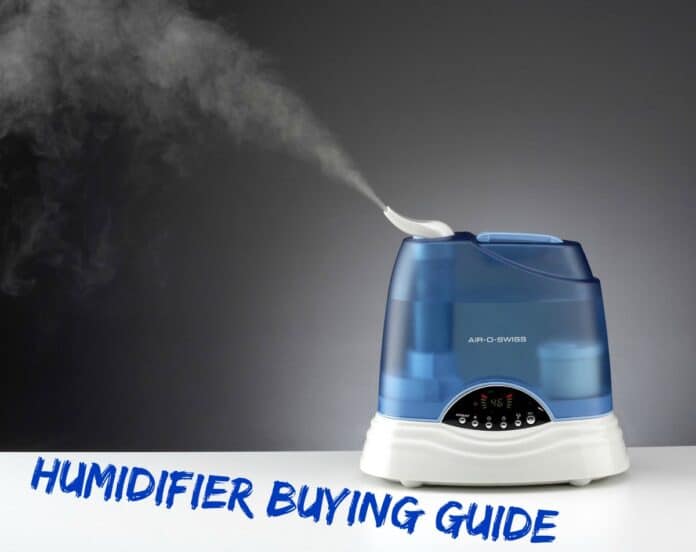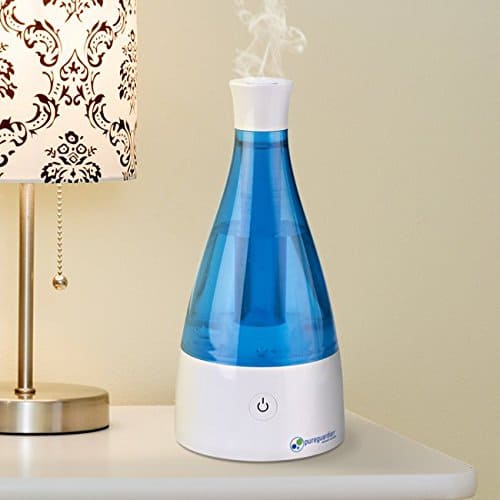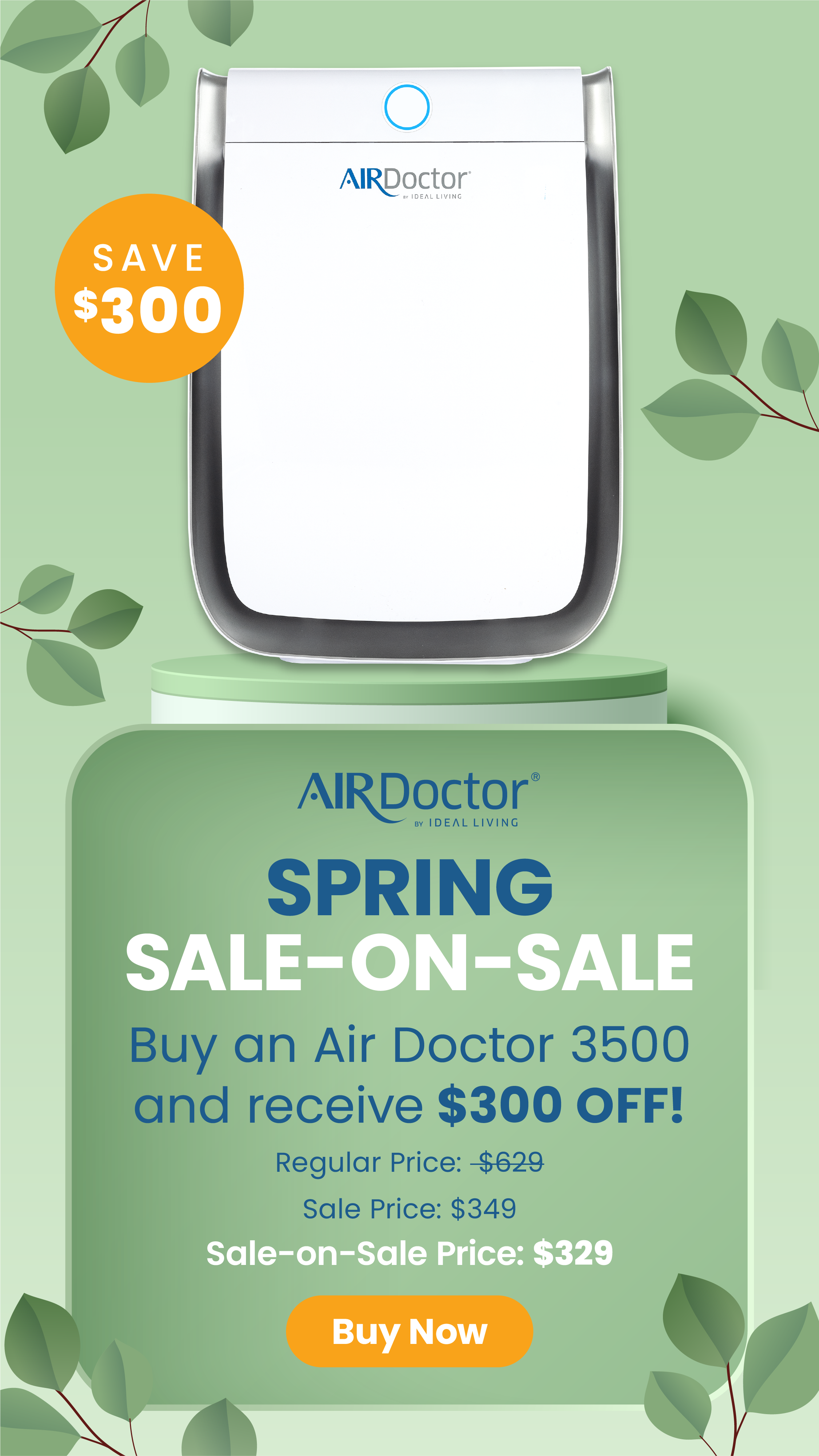The proper humidity level will help you relieve dry skin, maintain a respiratory condition, or relieve the common cold; a humidifier is an outstanding solution for improving indoor comfort and overall health. Humidifiers increase indoor humidity by adding moisture into the dry air like an invisible mist.
Humidifiers are most often used in the wintertime to help ease the physical discomforts created by winter heating. But they can also be used year-round to help ease respiratory problems and colds and keep several household items in excellent condition.
Table of Contents
Why Do You Need a Humidifier?
If the humidity level is below recommended (around 30 to 50 percent), you should use a humidifier to increase humidity to this level. Most popularly, humidifiers are used in colder months to battle dry air and decrease its negative effects on your health. When the air outside becomes cold during the autumn and winter, our standard method is to retreat indoors and crank up the heat. But while heating systems do a solid job of heating the air, they drastically decrease your air’s humidity level. Dry indoor air can lead to:
- Bloody nose
- Cracked lips
- Dry, scaly skin
- Dry sinus passages
- Sore, scratchy throat
- Aggravated respiratory ailments
Humidifiers also help control respiratory illnesses caused by asthma flare-ups, allergies, colds, sinus infections, congestion problems, and other illnesses. The mist coming from a humidifier eases your breathing passages. Some models even have special medicine cups that enable you to combine respiratory medications released into the air and the mist.
Dry air can also affect your home’s furniture and interior.
For example, dry conditions can wreak havoc on the wallpaper, causing it to peel at the edges. Wood floors and furniture items may lose moisture and contract, leading to ugly cracks, warps, and separations.
Besides, static electricity can increase, causing sudden and painful shocks and potential damage to electronic equipment. Regularly running a humidifier to increase the moisture content in the air will help eliminate these problems.
Measuring Humidity Level
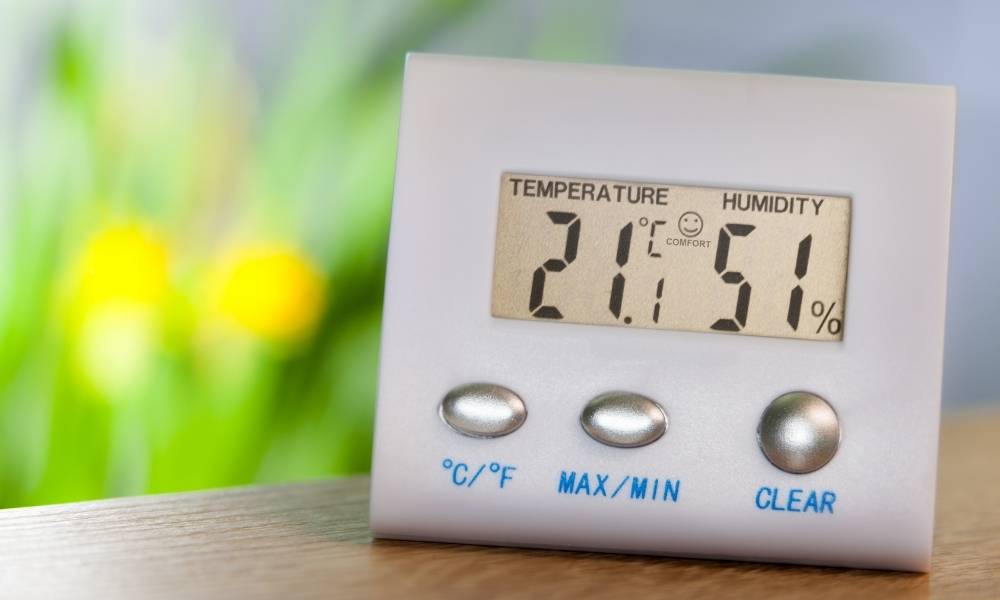
As you read above, the ideal humidity level in a home or building is between 30 to 50 percent (according to the Mayo Clinic). It is essential to keep balanced indoor humidity throughout the year to feel comfortable and healthy.
Humidity that is higher than 50 percent encourages bacteria, dust mites, mold, and other symptom-aggravating allergens. These wet and muggy conditions may develop an unpleasant, musty odor and cause wood to rot, walls to stain, and paint to peel.
On the other side, environments with humidity measuring under 30 percent will leave you susceptible to dry air’s adverse health effects and your interior furnishings vulnerable to damage.
How can you know what your actual indoor humidity level is?
It is a simple and quick process. It would help if you had an inexpensive digital hygrometer.
These devices display accurate readouts of the humidity level and temperature. They can usually be wall-mounted for regular use.
They may include extra features such as Celsius/Fahrenheit conversion, large internal memories, optimal humidity level warnings, and simple reading backlights.
I have made some research for you, so if you are searching for a hygrometer, you might check my 12 best indoor hygrometers article.
Some humidifier models include built-in hygrometers and humidity control sensors known as humidistats to help you precisely measure and adjust your home’s humidity.
Choosing Size and Capacity
If you want a humidifier in your bedroom, buying a big whole-house humidifier is unnecessary. If you want a humidifier to work in a whole house, it is better to buy a whole house humidifier than ten small humidifiers.
So as you read, humidifiers come in various sizes and capacities to suit your home or building’s requirements. Each unit is calculated for an area of coverage in square feet or by expected room size. A humidifier’s output capacity is measured in gallons of moisture per day.
Tabletop humidifiers
These are also known as room humidifiers and disperse enough moisture to humidify a single room. These humidifiers are portable and lightweight, often with removable water containers that make them simple to fill and clean. It is effortless to move them from space to space.
Few examples of tabletop humidifiers: Pure Guardian H920BL humidifier, GENIANI Desktop humidifier, and H20 portable mini humidifier.
Console humidifiers
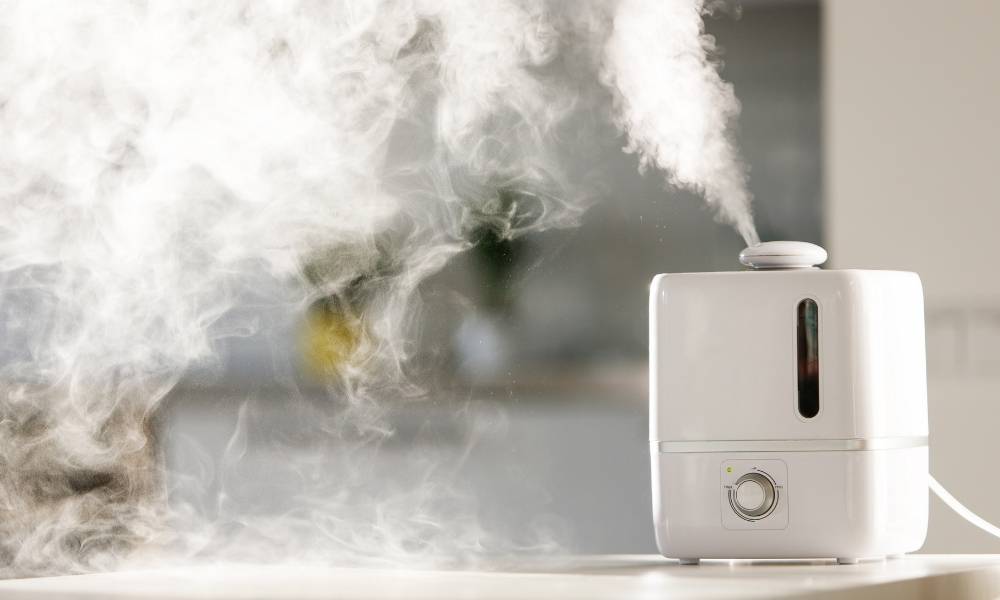
Console humidifiers are created to provide moisture to more than one room or an entire home or building measuring as large as 3,000 square feet in some cases. Usually, these units are portable but a bit heavier than tabletop humidifiers. They are typically placed on the floor in a centralized area and come in various designs that attractively disguise them as ordinary furniture.
Few examples of console humidifiers: Pure Enrichment HUME XL humidifier, Afloia Miro Pro humidifier.
Whole-House humidifiers

A whole-house humidifier covers the whole house. Usually, these units are installed onto your HVAC system and connect straight to your water line.
When the air is heated or cooled, it moves through a humidifier pad that has been saturated with water. The air absorbs moisture from this pad and is released into your home as humidified air.
The best thing is that you don’t have to refill your humidifier – if the system needs more water, it just draws it from your home’s water supply.
Few examples of console humidifiers: Aprilaire 500 Whole-Home Humidifier, Honeywell HE280A Whole House Humidifier.
The tank size and moisture output capacity are significant. You don’t want a powerful humidifier that needs to remove water every 3 hours. Some small tank humidifiers have a feature that allows them to work longer using less water.
Determining the Right Type
Humidifiers add moisture to the air in various ways, and each type offers its benefits and drawbacks.
Cool mist humidifiers can add moisture to small and large areas, even entire houses. Cool mist humidifiers use less electricity because the water is not heated before it is dispersed.
Also, cool mist humidifiers are safer to use if young children are in the home. That’s because a warm mist humidifier works with a heating element that heats the water in the container to create a steam mist that is expelled into the room.
Warm mist humidifiers boil the water before releasing it into the room. Warm mist humidifiers are often rated healthier since the boiling process kills waterborne bacteria and mold, which prevents them from entering the air you breathe.
They are a little quieter than cool mist humidifiers. Besides, warm mist humidifiers are more expensive to operate. They require more frequent cleaning because warm water is in the unit, which encourages bacterial growth.
Picking the right humidifier depends mainly on your comfort needs, budget, and enthusiasm to perform maintenance. Ask yourself these questions:
Do you want to feel warm mist or cool mist?
All humidifiers can make you indoors feel warmer by increasing the humidity. But, some models can temporarily change the temperature of your surroundings. Warm mist humidifiers make your place feel warmer, while cool mist models disperse moisture at room temperature (sometimes make your place feel cooler).
How significant is the noise factor?
Warm mist humidifiers are usually less noisy than cool mist humidifiers because they don’t use a fan. Ultrasonic humidifiers are even quieter, making them excellent choices for bedrooms and other quiet environments.
How much maintenance is expected?
Evaporative humidifiers, which use a wick filter, require a filter replacement or a thorough filter cleaning regularly. Units that run without a filter need to undergo regular maintenance. If your humidifier is equipped with a demineralization filter, a germ-reducing insert, or an ultraviolet light bulb, you’ll need to replace these elements at the manufacturer’s suggested intervals.
Humidifier Cost
Compared to dehumidifiers, humidifiers are inexpensive. Prices start at around $20 for portable room humidifiers. Multiple rooms or whole house humidifiers are also inexpensive.
You can get a whole-house humidifier starting from $120. Humidifiers with lots of features such as programmable timers, electronic controls, humidistats, etc., can cost a lot more. It all depends on you – if you need these features or not.
Cool mist humidifiers can have less influence on your power bill because, unlike warm mist units, they do not require extra electricity to heat the water. However, the power demand of a warm mist humidifier is equivalent to the electricity needed to heat a teapot, so you may not even see a difference.
Comfort Features
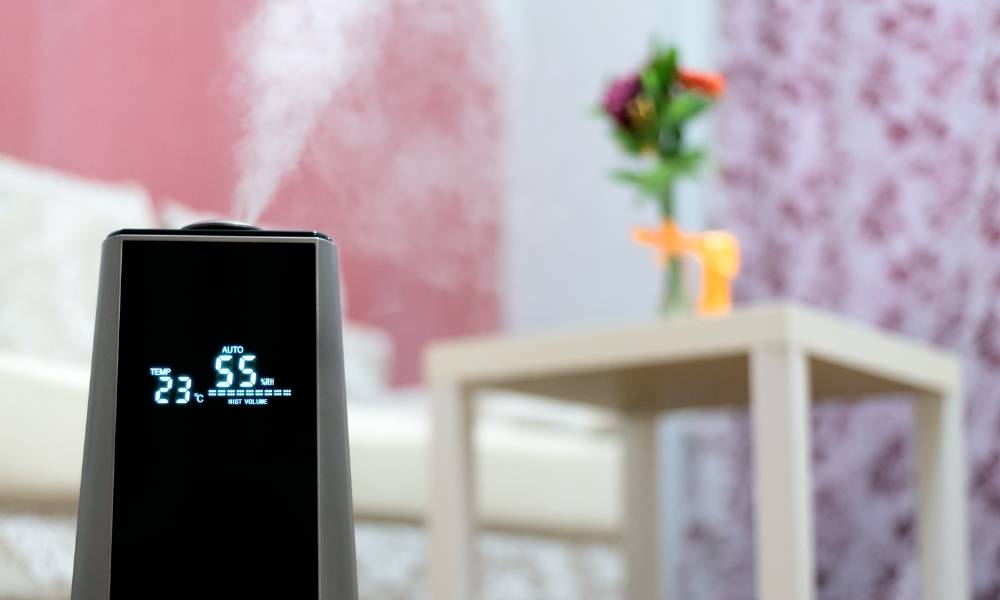
Humidifiers include many features and controls that make operation more comfortable. Some well-known ones to look for include:
- Variable Speeds. It is important (at least for us) that your humidifier has more than one speed because selecting from more than one operating speed lets you control a humidifier’s moisture output and limit power usage. Also, multiple speeds help you adjust the noise level.
- Built-In Hygrometer/Humidistat. A hygrometer measures the quantity of moisture within a place and tells it as a percentage, so you will always know if the humidity is within the recommended range (30 to 50 percent). A humidistat operates identically, but it can automatically turn the unit on and off to maintain a preset humidity level.
- Automatic Shutoff. We think this is a must feature. If the humidifier has an automatic shutoff, it automatically turns off when the water reservoir is empty. This is important for safety reasons as well as for energy efficiency.
- Digital Control Panel helps to ease your life. Digital measurements tell you exactly where your humidity falls and help you make precise changes. While analog controls are helpful, they may not give you the accuracy of a digital control panel.
- Indicator Lights. These lights signal you when the humidifier’s water tank runs low, filters or other parts need to be replaced, or when it’s time to clean your humidifier.
- Demineralization Cartridge eliminates mineral content from your water to reduce the risk of white dust. Breathing white dust can exacerbate existing respiratory diseases and cause new ones to develop.
Maintenance and Care
If you do not maintain your humidifier properly, it can work for your health. All humidifiers, and warm mist units, need regular cleaning and disinfection to curb bacteria, mold, and mineral growth.
If this is not done, pollutants can be released into the air you breathe. Over time, breathing polluted air may aggravate allergies and asthma, trigger flu-like symptoms, and contribute to a lung infection.
If you use your humidifier every day, you should clean it at a minimum once a week. Follow the manufacturer’s instructions in your product manual to clean and care for your humidifier. Consider using distilled or de-mineralized water to help decrease the number of mineral deposits that may develop. Change filters and other parts regularly.

